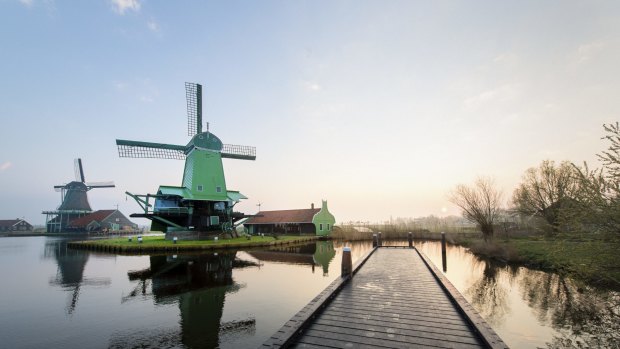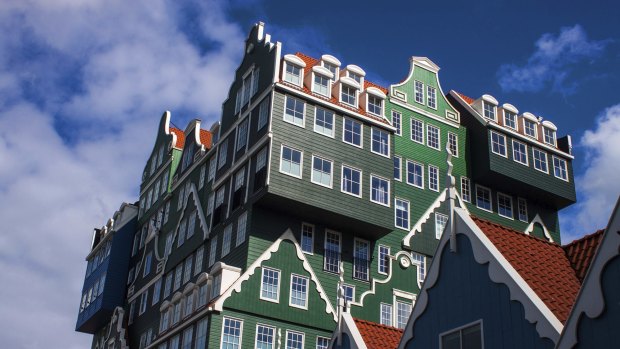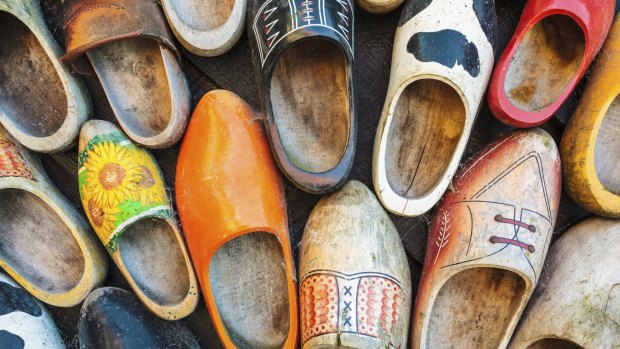This was published 9 years ago
Zaan, Netherlands: Dutch insert humour into architecture
Changes in The Netherlands landscape as architects have taken a whimical brush to the Zaan region have opened a new door to tourism, though some traditionalists have yet to see the lighter side. Richard Tulloch cycled to see.

Typical scene: Traditional Dutch windmills at the Zaanse Schans in The Netherlands, seen from a yetty.Credit: iStock
Dutch architects have been hard at work in and around Amsterdam, inserting colourful humour into some very public buildings and it's remarkable that, in the Zaanstreek, local planning authorities have been happily going along with the joke.
It's remarkable because the Dutch are not noted for being whimsical. They're a nation of merchants, shipbuilders and sailors. Their farmers have spent generations slogging around in clogs, shovelling manure onto fields, while engineers laboured through the centuries to keep the whole country from sinking into the sea. These serious pursuits are on display in the Zaanstreek, the district along the River Zaan.
The Zaan region is a short train or bus ride from Amsterdam. Just for a laugh, I decided to travel there the Dutch way, on the bike, a pleasant 40 kilometre round trip through the Twiske nature reserve. It was a very sensible decision. The Twiske's fields, forests, lakes and wetlands are popular with recreational cyclists, walkers and picnickers. The land is flat and the cycle paths safe and well signposted.

Captured: Architecture in Zaandam, Netherlands.Credit: iStock
It takes me just over an hour to reach the Zaan. I knew I'd arrived when I saw the tourist buses disgorging visitors to take their selfies in front of the windmills on the riverbanks, turning slowly under sail.
Local farmer Cornelis Corneliszoon patented a crankshaft in 1597 and his windmill could saw logs 30 times faster than anyone could do it by hand. What seems to us now such an obvious device, converting circular motion into linear, turned the Zaanstreek into the first industrialised area of Western Europe. Soon there were more than six hundred mills in the region, grinding corn, sawing timber and mixing paint to support the mighty Dutch marine industry.
Several of the 12 remaining windmills, maintained by enthusiasts, are open to the public in the theme park known as the Zaanse Schans, now one of Holland's biggest tourist attractions, with 800,000 visitors each year.

The heritage: Colourful vintage Dutch wooden clogs.Credit: iStock
Calling it a "theme park" makes it sound false and cheesy, and indeed it does feature all the cliches that many visitors associate with The Netherlands – clogs, cheese, tulips and of course those windmills.
However, the charming wooden houses with their dark green walls, white window frames and terracotta roofs are authentic 18th and 19th century originals, moved here since the 1960s from other parts of the country to create a living, working village.
There are small museums of clogs and clocks and casks. There's a sweet shop and a recreated grocery store. Some houses have genuine Dutch families living in them, paying affordable rent in return for maintaining them in their original state and putting up with tourists stickybeaking through their lace curtains.
My first stop is the clog museum, where I could admire more weird and wonderful clogs than I ever thought I needed to know about; plain ones for work, elaborately painted ones for Sunday best. There were even a few jokey ones, with funny faces.
In the workshop a clog-making demonstration is in full swing, with an English commentary that is entertaining, if slightly, ``I've told this one 10 times already today; it always gets a laugh." A tour guide translates it into Russian for her bus party. They laugh too.
Making a pair of wooden ``klompen" by hand used to take two to three hours, we are told. We don't have to wait that long. Our Zaanse clog expert does the job with an electric machine, rather like a 3D version of a key cutter. The blank model turns on a spindle, while next to it the chips fly from a lump of wood as the machine carves a clog in less than five minutes.
The Russians applaud. The clog-maker takes a mock bow, "on behalf of the machine", he jokes.
The Museum van het Nederlandse Uurwerk, the Museum of Dutch Clockwork, is not a large museum but it holds a wonderful collection of examples of the clockmaker's art through history, with an enthusiastic and knowledgeable English-speaking guide.
I skip quickly through Catharina Hoeve ('homestead'), more a cheese shop than a working dairy and other gift shops, not being in the market for Delft blue pottery, diamonds or wooden tulips.
Then I climb back in the saddle and follow the river into the township of Zaandam.
Russian Czar Peter the Great came to Zaandam in 1697 to study shipbuilding. A sculpture in the town square, a gift of the Russian government, commemorates his stay and the house in which he lived, albeit for just eight days, is now a small museum.
Artist Claude Monet also spent some months living and working in Zaandam in 1871 and a little blue house he painted (that is to say "depicted on canvas") still stands in the Hogendijk.
Then exactly 100 years later Zaandam staked a further claim to historical fame, as the proud location of mainland Europe's first McDonald's restaurant, 1971.
Now Zaandam has a new card to play in the quest to attract visitors. Last year, the main shopping drag underwent a radical transformation. The Gedempte (filled in) Canal was unfilled, turned into a real canal running down the middle of a mall from which cars and even bikes are excluded. The result is a thriving retail strip – one of Holland's busiest, the canal crisscrossed by little bridges with plenty of places to sit by the water.
At the station end is a group of extraordinary buildings, one of which is fast becoming one of the best known in the country.
Zaandam's Inntel Hotel, opened in 2010, looks like a cluster of more than 60 traditional Dutch wooden houses, piled on top of each other by a playful child to create a higgledy-piggledy structure twelve storeys high. Architect Wilfried van Winden even perched a tribute to Monet's blue house in a top corner.
The designer fun continues inside, with rooms decorated with wall-sized photos and advertising posters from the Verkade biscuit and chocolate factory, a Zaanstreek institution.
To complete the architectural joke, Zaandam's brand new Stadhuis (town hall) and council buildings are also constructed with a wink to traditional Zaanse Schans style. They're oversized wooden structures, with huge Dutch gables and rows of colourful artificial tulips lining fences at the entrance.
All of this was predictably a controversial development, with serious opposition even from Dutch friends of mine who don't completely lack a sense of humour. ``Horrible kitsch! A punchline to a joke that will soon wear thin!" growled some killjoys. But Zaandam resident Marlies tells me she loves it, ``If you'd seen what was there before…Zaandam was nothing!"
Love it or loathe it, it's certainly daring, different and undeniably Dutch. Architecture as fun has unquestionably put Zaandam on the tourist map. It gives me a smile that lasts most of the way as I ride back to Amsterdam. That can't be bad.
FIVE OF AMSTERDAM'S WITTIEST BUILDINGS
A walk or bike ride east of Central Station takes you to the recently reclaimed land of Java Island, where cute narrow houses line cute narrow canals, just as in Amsterdam's 17th century canal belt. Except that on Java Island they're all late 20th century buildings.
IJDok, a development west of Central Station, opened last year. As well as offices, law courts and a hotel, there are private residences, including one apartment spread vertically over nine floors, with 160 stairs and no lift. That must have given the architects a laugh.
The ING Bank headquarters is known locally as "the stofzuiger" - the vacuum cleaner. It reminds me more of Dr Who's robotic dog K9.
You can't miss EYE film museum, just across the IJ harbour from Central Station, its white-tiled shape looking accidentally flattened. Imagine Sydney Opera House, squashed by a chunk of falling sky. A free ferry will take you across for a closer look.
Also across the IJ is NDSM wharf. Just for a laugh, sleep in the Faralda NDSM Crane hotel. It has only three rooms, high up in a converted shipping crane. Yes, there's a lift. And a jacuzzi and bungy jumping. See faralda.nl. Another of those free ferries leaves from behind the train station.
TRIP NOTES
MORE INFORMATION
GETTING THERE: Trains from Amsterdam Central Station to Zaandam leave several times an hour and the trip takes 12 minutes. Bus 391 departs every half hour from Amsterdam Central and takes 40 minutes to reach the Zaanse Schans. Or you can take the train to Koog-Zaandijk (17 minutes) and walk 15 minutes across the river.
STAYING THERE: Hotel Inntel in Zaandam has double rooms from $135.18(EUR93) a night. See inntelhotelsamsterdamzaandam.nl
WHILE YOU'RE THERE: Entry to the Zaanse Schans is free, though there are charges for some of the museums. See dezaanseschans.nl Tip: A Zaanse Schans Card ($14.54 EUR10) gives free access to most museums and discounts at some of the shops and restaurants. A Museumkaart ($73 EUR50) gives unlimited entry to most museums in the Netherlands for a year, including those at the Zaanse Schans and Zaandam. Buy one online or at any major museum in the country, including the clockwork museum at Zaanse Schans. See museumkaart.nl
Sign up for the Traveller Deals newsletter
Get exclusive travel deals delivered straight to your inbox. Sign up now.